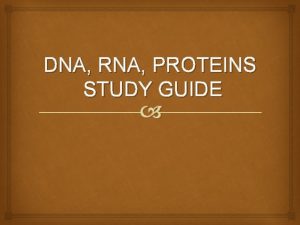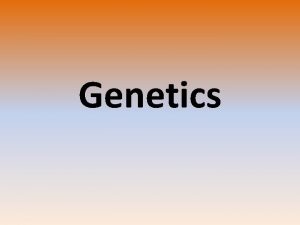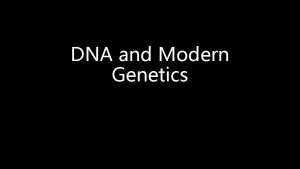GENETICS AND DNA Genetics is the study of












- Slides: 12

GENETICS AND DNA • Genetics is the study of how traits are passed from parent to offspring. • Genes - sections of the chromosomes found in cells; control these traits. • DNA is a molecule located on a chromosome that makes up genes and determines traits of all living things.

Genome • Genome: Complete complement of an organism’s DNA. – Includes genes (control traits) and noncoding DNA organized in chromosomes.

CHROMOSOMES Located in Nucleus – Split and Produce New Cells – Contain Genes • BODY CELLS – Make up most of the body’s tissues and organs – 2 of each chromosomes for a total of 46 • SEX CELLS – Can be a sperm cell (male) or an egg cell (female) – Only 1 kind of each chromosome; half as many as chromosomes in body cells

Genes • Eukaryotic DNA is organized in chromosomes. – Genes have specific places on chromosomes.

STRUCTURE of DNA • Holds information needed for cell function and carries information needed to make proteins. • Model looks like a ladder in a twisted shape. • DNA backbone (or sides) are made up of alternating sugars and phosphates. • “Rungs” of the ladder are composed of 4 nitrogen bases (adenine, thymine, cytosine, guanine) which are joined together in a specific order (via a covalent bond which is very strong).

STRUCTURE of DNA • This order is based on our genetic history, and makes up our genetic characteristics (eye, hair color; ear shape and size, etc. ). • These 4 bases form a ‘code’ which spells out a certain ‘message’. • This code is similar to the way the 26 letters in our alphabet combine to form words.

DNA STRAND • A ALWAYS pairs up with T; • C ALWAYS pairs up with G • A-T; C-G

DNA -vs- RNA • DNA • Sugar= deoxyribose • Nitrogen bases a. Adenine • b. Guanine • c. Cytosine • d. Thymine • Double stranded molecule • • RNA Sugar= ribose Nitrogen bases a. Adenine b. Guanine c. Cytosine d. Uracil Single stranded

The making of RNA • RNA is formed from DNA: The strands split at the (weak) hydrogen bonds where needed to make m. RNA. (messenger RNA) • The thymine (T) in DNA is replaced with uracil (U). • This process takes place in the ribosomes within a cell. • Process is referred to as transcription.


TRANSLATION: language of amino acids – creation of a protein • m. RNA is the blueprint that tells the order of amino acids • m. RNA is the CODE composed of a single strand of nucleotides (A, U, C, G) • Nucleotides divided into patterns of 3 letters in a row – (triplet codon) = 1 amino acid • Each codon forms long chain to produce proteins. • STOP codons (UAA, UAG, UGA) tell ribosomes when to stop making a proteins

From Genes to Proteins
 Coding dna and non coding dna
Coding dna and non coding dna Molecular genetics section 1 dna the genetic material
Molecular genetics section 1 dna the genetic material Replication fork
Replication fork Bioflix activity dna replication dna replication diagram
Bioflix activity dna replication dna replication diagram What are the enzymes involved in dna replication
What are the enzymes involved in dna replication Dna rna protein synthesis homework #2 dna replication
Dna rna protein synthesis homework #2 dna replication Genetics is the study of heredity and variation.
Genetics is the study of heredity and variation. Dna rna and proteins study guide answers
Dna rna and proteins study guide answers Rna and protein synthesis study guide
Rna and protein synthesis study guide Chapter 7 extending mendelian genetics
Chapter 7 extending mendelian genetics Hình ảnh bộ gõ cơ thể búng tay
Hình ảnh bộ gõ cơ thể búng tay Bổ thể
Bổ thể






















